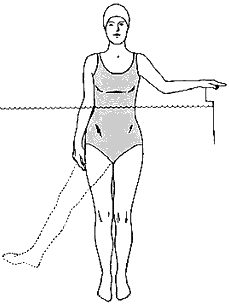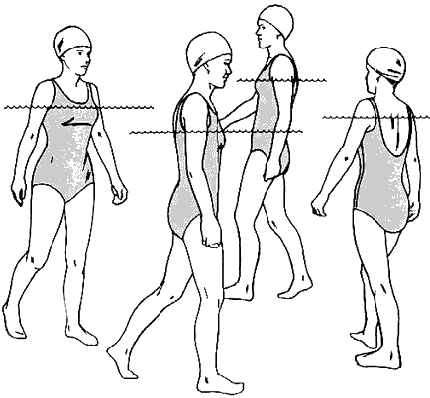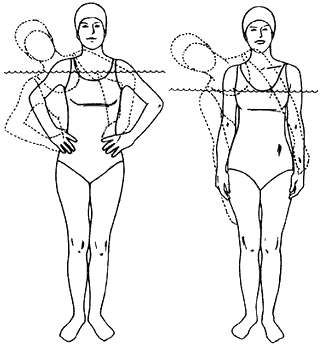Pool and Arthritis
Warmth support and relaxation
Exercises in water can be most helpful and enjoyable for people with arthritis.
Water can provide warmth and support (buoyancy) which can facilitate the exercising of joints affected by arthritis. Spas can provide ready access to warm water exercises in the home. Soaking in warm water allows muscles to become relaxed which can then make it easier to perform exercises and carry out daily tasks. Relaxed muscles can also create an overall feeling of comfort. Pools also enable people with arthritis to relax and exercise their joints often in the company of others. Pools offer more space than spas, allowing for a wider variety and more vigorous exercises.
In this article
Provided here is information on the benefits of warm water exercises and specific examples of water exercises that have been helpful for individuals with arthritis. At the end of this section is some detailed information for those who are considering using or purchasing a home spa or pool. If your doctor or other health professionals advise you to follow a regular program of water exercises and this medical treatment is your primary reason for buying a home spa or pool, all or a part of your purchase price may qualify for income tax deduction as a medical expense.
Benefits of water exercise
Keeps joints moving
Pain in your joints may make you want to hold them very still as moving can be painful. However, immobilizing your joints or not using them will over time cause the joints, ligaments and muscles to lose range of motion and weaken. Muscles may also shorten and tighten up, causing you to feel more pain and stiffness and be less able to do the things you want to do.
Regular exercise helps keep joints moving, restores and preserves flexibility and strength, and protects joints against further damage. Exercise can also improve a person's coordination, endurance and ability to perform daily tasks and can lead to an enhanced sense of self-esteem and accomplishment.
Exercising in water is a gentle way to exercise joints and muscles. The buoyancy of the water supports and lessens stress on the joints and encourages freer movement. Water may also act as resistance to help build muscle strength. Consult your doctor to determine whether water exercises are appropriate for you.
Heat
The use of heat is recommended for many people with arthritis, but not all. Your doctor can help you determine if it is appropriate for you. People whose arthritis symptoms respond well to heat have discovered many benefits. They have found that heat can to a great extent relax their muscles, decrease pain and stiffness and allow them to move through their exercises and daily activities with greater ease.
Warm water is an especially good way to deliver and distribute heat to many parts of the body. Extremely hot water is not safe and is not necessary to get results. Mild heat is just as effective and easier for the body to tolerate. The water temperature should feel soothing and comfortable, not hot. In a pool, water temperatures between 83 to 88 degrees are usually comfortable for people who are exercising. People who are just soaking or doing very gentle movements while sitting in a spa can usually tolerate higher temperatures. Soaking time will vary depending on the water temperature and an individual's tolerance to heat. New spa users should vary the temperature and length of stay until they can determine what is most comfortable. Start slowly and extend the time in the spa as tolerated. For most people, soaking time should not exceed 10-15 minutes at temperatures between 98-104 degrees. Remember too that children and elderly persons are more prone to become overheated.
Doctors often advise that people with arthritis soak in warm water in the morning before beginning their daily activities. This is a time when many people find that pain and stiffness is at its worst. It may be just as beneficial to use spas or warm water pools at other times: in the afternoon to help relax muscles and joints after a full day of activities; to loosen muscles before doing exercises; in the evening before bedtime to bring on a restful sleep.
Warm water exercises
General guidelines
When first entering a spa or pool, relax and enjoy the soothing water. When your muscles and joints feel more comfortable and relaxed, slowly begin your exercise routine. Allow enough time after exercising to again relax muscles before getting out of the water.
The Arthritis Foundation recommends the following guidelines when doing water exercises:
- Submerge body part being exercised.
- Move the body part slowly and gently.
- Begin and end with easy exercises.
- Follow through complete joint range of motion if possible, but do not force movement. Stop if you experience any sudden or increased pain.
- Do three to eight repetitions as tolerated.
- Pain that lasts for more than one to two hours after exercise may indicate overuse. Cut back next time.
- Remember the weakening effects of heat when exercising in warm water.
- Start slowly and don't overdo.
- Any individuals who have severe joint damage or joint replacement should check with their doctor or surgeon before doing any of the following exercises.
The following illustrations of exercises can be done while sitting in a spa or while sitting or standing in a pool. Consult your doctor or physical therapist to determine which exercises are appropriate for you.
Forward arm reach
Sideways arm reach
Arm circles
Elbow bend
Wrist turn
Thumb circles
Knee bend
Spread eagle hip
Shoulder
Forward arm reach (flexion):
- Raise one or both arms forward and upward as high as possible. If one arm is very weak, you can help it with the other arm. See figure 1.
Sideways arm reach (abduction):
- Slowly raise both arms out to the side, keeping the palms down. Raise only to shoulder (water) level. Then lower arms. See figure 2.
Arm circles (combined motions):
- Raise both arms forward until they are a few inches below water level. Keep both elbows straight. Make small circles (about the size of a softball) with the arms. Gradually increase circle size (until the size of a basketball). Then decrease. First make inward, then outward circles. Do not raise your arms out of the water or let them cross. See figure 3.
Elbow
Elbow bend (flexion/extension):
- Bend the elbows and the thumbs to the shoulders. You do not have to touch. Relax elbows and straighten down along side of you. See figure 4.
Elbow bend and turn (combined motion):
- Turn the arms until the palms face forward. Bend the elbows until the fingertips touch the shoulders. Relax and straighten your elbows leading down with your palms. See figure 5.
Wrist and fingers
Wrist turn (supination/pronation):
- Turn the palms toward the ceiling, then turn them down to face the bottom of the spa or pool. See figure 6.
Wrist bend (flexion/extension):
- Bend the wrists backward and then forward. See figure 7.
Hand and fingers
Finger hold (thumb opposition):
- Touch the tip of the left thumb to the tips of the other fingers one at a time to form a round letter "O". Repeat with right thumb. (May move both thumbs at the same time.) See figure 8.
Finger curl (flexion/extension):
- Curl the fingers into the palm (making a loose fist) and then straighten them out. See figure 9.
Thumb circles (circumduction):
- Move the thumb in a large circle. See figure 10.
Ankle and toes
Ankle bend:
- Sit with back supported and slowly straighten your knee. While holding the knee straight, bend the ankle and point the toes. Then reverse to point them toward the ceiling. See figure 11.
Toe curl (flexion/extension):
- Curl right toes down and then straighten them out. Repeat with left foot. See figure 12.
Ankle circles (dorsiflexion/plantar flexion and inversion/eversion):
- Sit with back supported and slowly straighten your knee. While holding the knee straight, make large inward circles with the foot moving from the ankle. Then repeat circles in the opposite direction. Repeat with other foot. See figure 13.
Hip and knee
Knee bend (flexion/extension):
- Slowly raise one foot up to straighten out your knee. Hold straight 3 seconds. See figure 14.
Knee to chest (combined stretch):
- Sit erect. Lift one knee and hug towards chest, hands under the thighs or over the knee to assist with the stretch. See figure 15.
Spread eagle hip (abduction with knee extension):
- Sitting on the edge of the seat, straighten one knee. While holding it straight, slowly move it out to the side, hold 3 seconds then bring it back to the center. Repeat with other leg. See figure 16.
Leg swing (hip flexion/extension):
- Stand with left side to pool wall, holding wall with left hand for balance. Keep knees straight. Lift right leg slowly forward to a comfortable height. If possible, hold leg for a count of 5 seconds, then slowly swing leg backward. Motion should only occur in hip (not waist or neck). Keep upper body straight at all times. Repeat with left leg--right side to wall. See figure 17.
Knee lift (hip and knee flexion/extension):
- Stand with back or left side against pool wall. Bend right knee, bringing thigh parallel to water surface. Straighten the knee; then bend it again. Lower leg, keeping knee bent. Repeat on left. See figure 18.
Calf stretch:
- Stand with left side to wall, holding wall with left hand for balance. Stand straight with legs slightly apart and left leg forward of right. Keeping body straight, lean forward slowly letting left knee bend. Keep right knee straight and heel on bottom. Court 5. Return to starting position. Repeat with right leg forward, right side to pool. See figure 19.
Side leg lift (hip abduction and adduction):
- Stand with left side to pool wall, holding wall with left hand for balance, knees relaxed. Swing right leg out toward center of pool and back to midline. Do not cross in front of left leg. Repeat with left leg--right side to wall. See figure 20.
Walking:
- Walk normally across or in a circle in the pool. Swing your arms as you walk. See figure 21.
Trunk
Side bend (flexion):
- Place hands on hips and without moving your feet, bend slowly toward the right; then return to starting position and bend to the left. Do not twist or turn the trunk. Arms may hang at the side if preferred and as you lean to the right, let the right hand slide down the thigh. Repeat on the left. See figure 22.
Buying a spa
Thinking of buying a spa?
The spa and pool industry has made it more convenient for people to own, install and receive the benefits of a spa or pool in their own home. Spas and pools can be installed inside or outside your home.
Before purchasing a spa or pool you may want to consider the following:
- Does warm water relieve the symptoms of your arthritis?
- Does the size and shape give you adequate room to exercise, especially hip and leg exercises?
- Is it relatively easy for you to get into and out of?
- Are hand controls easy to use and within easy reach while seated in the spa?
- Is it possible to install handrails and grab bars to facilitate easy entry, exit or moving?
- Are seats or stairs wide enough and comfortable?
- Does the spa or pool have or can you install slip resistant surfaces?
- Are there sharp corners and edges?
Most companies will allow potential buyers to sit in a spa to determine which model is most comfortable and best suited to their needs.
As a consumer of health care, ask questions. Judge for yourself the effects and safety of a spa or pool as you would with any new treatment method for arthritis before you try it. Ask your doctor if you need more information.
Precautions
If you own or are planning to purchase a spa or pool, you are encouraged to use it safely. Ask your sales representative for a booklet containing general safety tips and also follow the medical precautions listed below:
- Consult with your doctor before using or purchasing a spa or pool if you have any special medical conditions such as: lung or heart disease, circulatory problems, high or low blood pressure, diabetes, multiple sclerosis, thyroid disease, skin irritations or any other serious illness.
- Consider that you may need help getting in and out of the spa or pool. Someone else should be nearby for help, if necessary, especially the first few times.
- Check the thermometer for appropriate temperature before entering and while in the spa or pool.
- Remember that individuals react differently to heat; therefore, anyone who feels lightheaded or nauseated should get out of the water immediately.
- If joint swelling, stiffness or pain increases, discontinue the use of heat and exercise and consult your doctor.
- Never use a spa or pool while or after using alcohol or drugs. These may cause sleepiness, drowsiness or may raise or lower blood pressure.
- Pregnant women should not enter a spa without first consulting their doctor.
Credits
Some of this material may also be available in an Arthritis Foundation brochure.
Adapted from a pamphlet originally prepared for the Arthritis Foundation. This material is protected by copyright.




















